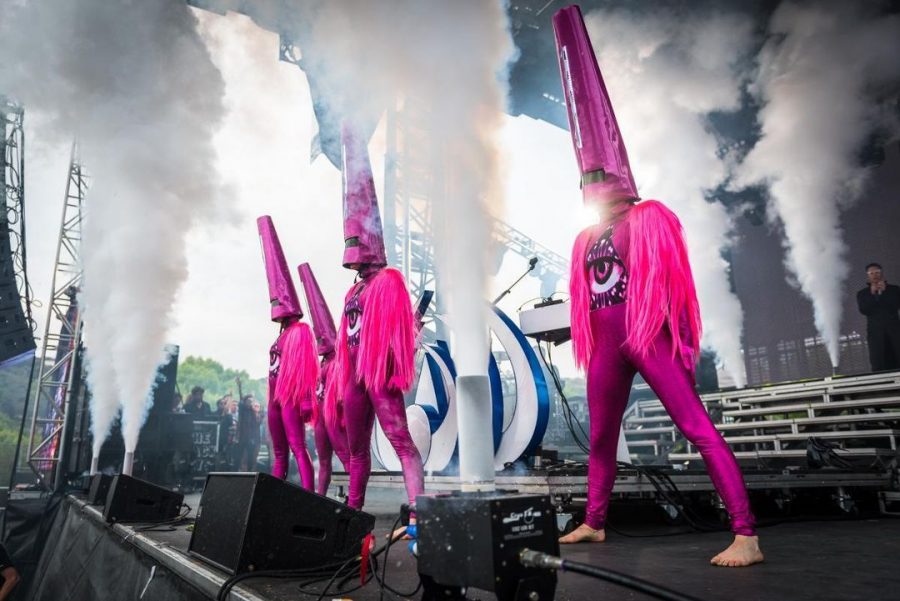Fashion designer Svetlana Shigroff and Santa Rosa Junior College students proved upcycling clothes is easier than you think at SRJC’s “Trashion Fashion” April 22.
Athena Weathers, Vice President of Student Life, said she had done the same event in 12th grade and thought it would be a good idea to bring the event to the SRJC.
“I love to do it and just being a part of something, which is really what this event is about,” she said. “Being part of the solution instead of the problem and finding out ways we can use things that we don’t think about as fashion or as accessories.”
Weathers sported a custom-made dress that she made fully out of bike parts, including pipe material, back tires, spokes and stitches made of tubing. She plans on adding additional spokes to make it more wearable for everyday life.
Guy Tillitson, SRJC’s waste diversion technician, came up with innovative ways to use recycled paper folders and plastic as a means of sun protection for the times when he needs to be pulling weeds on campus. He simply ripped a hanging file folder in half and stuck the metal bit in his hat so the paper protected his neck against the sun. As a rainy day solution, he cut a circle in the middle of a piece of plastic and placed it over his hat so he had 360 degree water protection.
Instead of throwing away a dress she wore at seven years old, Vice President of Sustainability Carolyn Marshall now wears it as a tank top.
Hilleary Zarate from the SRJC Dream Center wore a hand-me-down shirt from her sister and said she hardly buys anything new. She loves the creativity that comes with wearing second-hand pieces.
Director of Student Equity & Persistence Genevieve Bertone found a denim jumpsuit on the streets of Los Angeles while she was walking her dog. She believes it came from the “first flush,” which is when it rains in LA after a long time without and causes trash to rise from the ocean. She wore this jumpsuit to the Primavera Music Festival in Spain, and everyone asked where she bought it.
“I was like ‘Oh I got it in LA.’ It’s true. I did get it in LA. And they’re like, ‘Oh it’s LA fashion. You got it in LA? That explains why it’s so fabulous,’” Bertone said.
Artist and fashion designer Svetlana Shigroff attended the fashion show as a guest speaker. She followed the theme by wearing a navy collared shirt, which she bought from a thrift store and then did a bleach rinse to make it more unique. In fact, 80% of her clothes come from thrift stores. Shigroff is not foreign to trashion fashion, as she predominantly creates art with waste.
Shigroff used to work in the fast fashion industry in which a large amount of clothes are produced at a low cost at the expense of laborers and the environment. At her previous job she would collect extra materials. Although she had no idea what to do with them, she couldn’t bear seeing so much go to waste.
When the opportunity arose, she started to work independently as a sustainable artist and costume designer. She uses all secondhand material, which she gets from secondary shoppers who sell scrap fabric they get as waste from factories.
During her independent career she worked with Nasty Gal, a fast fashion retailer specializing in young women’s fashion, for a short while but called off her partnership due to ethical issues. She believes in paying people what they deserve, a practice not commonly seen in fast fashion institutions. She realized trying to create a certain number of units to get them into stores was not her passion, and she would rather make one-of-a-kind sustainable pieces.
“Fast fashion is super evil, but it is literally just a byproduct of the capitalistic society that we live in,” Shigroff said. “If we could remove the greed aspect, that would be really sweet.”
She also hopes the environment and people will become a hirer priority.
Shigroff sees sustainability gaining momentum in the fashion industry, especially in brand marketing. Her friend even said that she wanted to start a sustainable luxury brand. Shigroff thought this was a bit redundant.
“To me, luxury is knowing where your garment is made. Knowing who made your garment. Knowing that they were paid well to make a beautiful garment that then you will cherish until the end of its days,” she said. “You know maybe you will be able to give this to someone else so they can also cherish it. You know that to me is what luxury is.”




